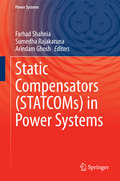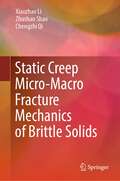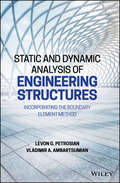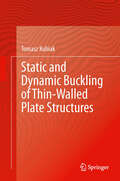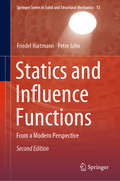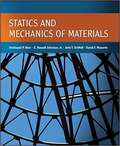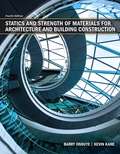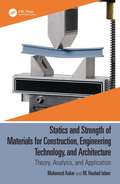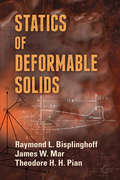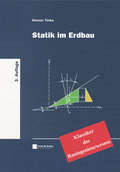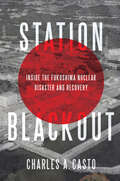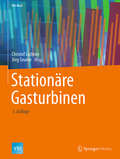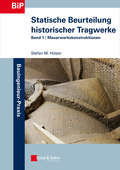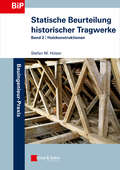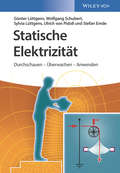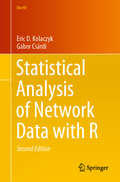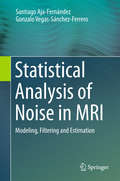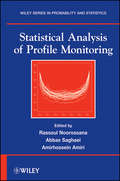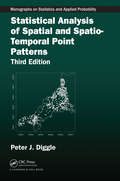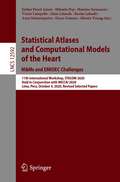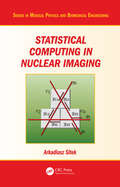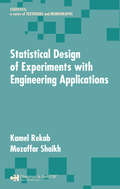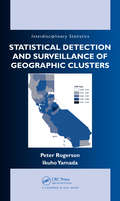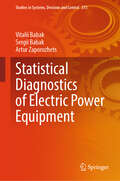- Table View
- List View
Static Compensators (STATCOMs) in Power Systems
by Sumedha Rajakaruna Farhad Shahnia Arindam GhoshA static compensator (STATCOM), also known as static synchronous compensator, is a member of the flexible alternating current transmission system (FACTS) devices. It is a power-electronics based regulating device which is composed of a voltage source converter (VSC) and is shunt-connected to alternating current electricity transmission and distribution networks. The voltage source is created from a DC capacitor and the STATCOM can exchange reactive power with the network. It can also supply some active power to the network, if a DC source of power is connected across the capacitor. A STATCOM is usually installed in the electric networks with poor power factor or poor voltage regulation to improve these problems. In addition, it is used to improve the voltage stability of a network. This book covers STATCOMs from different aspects. Different converter topologies, output filters and modulation techniques utilized within STATCOMs are reviewed. Mathematical modeling of STATCOM is presented in detail and different STATCOM control strategies and algorithms are discussed. Modified load flow calculations for a power system in the presence of STATCOMs are presented. Several applications of STATCOMs in transmission and distribution networks are discussed in different examples and optimization techniques for defining the optimal location and ratings of the STATCOMs in power systems are reviewed. Finally, the performance of the network protection scheme in the presence of STATCOMs is described. This book will be an excellent resource for postgraduate students and researchers interested in grasping the knowledge on STATCOMs.
Static Creep Micro-Macro Fracture Mechanics of Brittle Solids
by Xiaozhao Li Zhushan Shao Chengzhi QiThis book gathers a large amount of recent research results on this topic to better understand the static creep micro–macro fracture mechanics in brittle solids (e.g., glass, ceramic, concrete, ice, and rock). To be precise, this is about to explore the effects of the external factors of stress paths, water content, seepage pressure, dynamic disturbance, thermal treated temperature, and the internal factors of crack angle, size, recovery, and nucleation coalescence on the static creep fracture mechanical properties in brittle solids. This book provides important theoretical support in evaluation for long-term lifetime in the brittle solid engineering (e.g., deep underground engineering, architecture engineering, aerospace engineering, and mechanical manufacturing engineering).
Static and Dynamic Analysis of Engineering Structures: Incorporating the Boundary Element Method
by Levon G. Petrosian Vladimir A. AmbartsumianAn authoritative guide to the theory and practice of static and dynamic structures analysis Static and Dynamic Analysis of Engineering Structures examines static and dynamic analysis of engineering structures for methodological and practical purposes. In one volume, the authors – noted engineering experts – provide an overview of the topic and review the applications of modern as well as classic methods of calculation of various structure mechanics problems. They clearly show the analytical and mechanical relationships between classical and modern methods of solving boundary value problems. The first chapter offers solutions to problems using traditional techniques followed by the introduction of the boundary element methods. The book discusses various discrete and continuous systems of analysis. In addition, it offers solutions for more complex systems, such as elastic waves in inhomogeneous media, frequency-dependent damping and membranes of arbitrary shape, among others. Static and Dynamic Analysis of Engineering Structures is filled with illustrative examples to aid in comprehension of the presented material. The book: Illustrates the modern methods of static and dynamic analysis of structures; Provides methods for solving boundary value problems of structural mechanics and soil mechanics; Offers a wide spectrum of applications of modern techniques and methods of calculation of static, dynamic and seismic problems of engineering design; Presents a new foundation model. Written for researchers, design engineers and specialists in the field of structural mechanics, Static and Dynamic Analysis of Engineering Structures provides a guide to analyzing static and dynamic structures, using traditional and advanced approaches with real-world, practical examples.
Static and Dynamic Buckling of Thin-Walled Plate Structures
by Tomasz KubiakThis monograph deals with buckling and postbuckling behavior of thin plates and thin-walled structures with flat wall subjected to static and dynamic load. The investigations are carried out in elastic range. The basic assumption here is the thin plate theory. This method is used to determination the buckling load and postbuckling analysis of thin-walled structures subjected to static and dynamic load. The book introduces two methods for static and dynamic buckling investigation which allow for a wider understanding of the phenomenon. Two different methods also can allow uncoupling of the phenomena occurring at the same time and attempt to estimate their impact on the final result. A general mathematical model, adopted in proposed analytical-numerical method, enables the consideration of all types of stability loss i.e.local, global and interactive forms of buckling. The applied numerical-numerical method includes adjacent of walls, shear-lag phenomenon and a deplanation of cross-sections.
Statics and Influence Functions: From a Modern Perspective (Springer Series in Solid and Structural Mechanics #13)
by Friedel Hartmann Peter JahnThis extended and revised second edition is intended for engineering students and researchers working with finite element methods in structural and mechanical analysis. Discussing numerical structural analysis from first mechanical and mathematical principles, it establishes the central role of influence functions (Green's functions) in finite element analysis, reanalysis, sensitivity analysis, parameter identification and in optimization, with a particular focus on computational aspects and questions of accuracy. It also presents a one-click reanalysis, a new technique that allows instantaneous modifications to a structure to be made by clicking on single elements. Lastly, the book features four programs that can be downloaded for the solution of the Poisson equation, 2-D elasticity, plate-bending problems and planar frames.
Statics and Mechanics of Materials
by Ferdinand Beer David Mazurek E. Russell Johnston John T. DeWolfThe approach of the Beer and Johnston texts has been utilized by hundreds of thousands of students over decades of engineering education. The Statics and Mechanics of Materials text uses this proven methodology in a new book aimed at programs that teach these two subjects together or as a two-semester sequence. Maintaining the proven methodology and pedagogy of their other textbooks, Beer and Johnston’s Statics and Mechanics of Materials combines the theory and application behind these two subjects into one cohesive text. A wealth of problems, Beer and Johnston’s hallmark Sample Problems, and valuable Review and Summary sections at the end of each chapter highlight the key pedagogy of the text.
Statics and Strength of Materials for Architecture and Building Construction
by Barry S. Onouye Kevin KaneStatics and Strength of Materials for Architecture and Building Construction, Fourth Edition, offers students an accessible, visually oriented introduction to structural theory that doesn't rely on calculus. KEY FEATURES: Instead, illustrations and examples of building frameworks and components enable students to better visualize the connection between theoretical concepts and the experiential nature of real buildings and materials. This new edition includes fully worked examples in each chapter, a companion website with extra practice problems, and expanded treatment of load tracing.
Statics and Strength of Materials for Construction, Engineering Technology, and Architecture: Theory, Analysis, and Application
by M. Rashad Islam Mohamed AskarStatics and Strength of Materials for Construction, Engineering Technology, and Architecture: Theory, Analysis, and Application provides students and industry professionals with the necessary statics and strength of materials background for more innovative approaches to particular fields of engineering technology, construction engineering and management, civil engineering, and architectural technology. It presents an introduction to statics, a review of algebra and trigonometry, concepts of vectors, a classification of building structural systems, an overview of advanced topics in statics and strength of materials, and frameworks of real-world application projects.This book contains 19 chapters and discusses several topics related to statics and strength of materials, such as coplanar force systems; the equilibrium of particle and rigid bodies; design loads; beam and frame reactions; trusses; arches, cables, and pulleys; space force systems; centroid of areas; moment of inertia; friction; properties of materials; axial deformation; bending and shear stress; torsional stress; combined loading; stress transformation; deflection; and stress in columns.Each chapter includes an Instructor’s Solution Manual and Guide with instructional materials and comprehensive explanations of the related practice problems, critical thinking exercises, and application projects.
Statics of Deformable Solids (Dover Books on Engineering)
by Raymond L. Bisplinghoff Theodore H.H. Pian James W. MarWell-written, thoughtfully prepared, and profusely illustrated, this text is the work of a trio of prominent experts. The treatment builds on the mechanics background obtained from an engineering curriculum's first course in physics, providing the foundations for a study of such advanced topics in solid mechanics as the theory of elasticity, structural analysis, plasticity, and shell theory.Divided into two parts, the book begins with an exposition of the fundamentals of solid mechanics and the principles of mechanics, statics, and simple statically indeterminate systems. The second half deals with strain and stress in three-dimensional solids, elementary elasticity, stress-strain relations for plastic solids, and energy principles in solid continuum. Each chapter concludes with a set of problems and a concise summary of important principles.
Statik im Erdbau: Klassiker des Bauingenieurwesens
by Henner TürkeBei der statischen Berechnung von Erdbauten stehen die Probleme der Standsicherheit im Vordergrund. In diesem Buch werden die Nachweise für Böschungen, Dämme sowie Stützmauern behandelt und in übersichtlichen Tafeln dargestellt. Ausgewählte Zahlenbeispiele verdeutlichen die Zusammenhänge zwischen den Sicherheitsbedingungen. Die Erdbaumechanik, die den Hauptteilen "Erdbausysteme" und "Berechnungsverfahren" zugrunde liegt, ist eine beständige Grundlage der Statik im Erdbau. Damit ist dieser unveränderte Nachdruck des zuletzt 1999 erschienen Standardwerkes auch heute noch ein wertvolles Nachschlagewerk für die Planungspraxis. Das Buch erscheint in der Reihe "Ernst & Sohn ZEITLOS" als unveränderter Nachdruck.
Station Blackout: Inside the Fukushima Nuclear Disaster and Recovery
by Charles A. CastoThe nuclear safety expert shares a gripping, blow-by-blow account of how he led the response to the 2011 nuclear disaster in Fukushima, Japan. On March 11, 2011, fifty minutes after a magnitude 9.0 earthquake hit eastern Japan, a forty-five-foot high tsunami engulfed the nuclear power plant known as Fukushima Daiichi, knocking out electrical power and all the reactors' safety systems. Three reactor cores experienced meltdowns in the first three days, leading to an unimaginable nuclear disaster. The Tokyo Electric Power Company called Dr. Chuck Casto for help. In Station Blackout, Casto, the foremost authority on responding to nuclear disasters, shares his first-hand account of how he led the collaborative team of Japanese and American experts who faced the challenges of Fukushima. A lifetime of working in the nuclear industry prepared him to manage an extreme crisis, lessons that apply to any crisis situation.
Stationäre Gasturbinen
by Christof Lechner Jörg SeumeDas Handbuch bietet das aktuelle Wissen über stätionäre Gasturbinen in Industrie und Forschung. In fast vierzig Kapiteln werden die Grundlagen aufbereitet und der derzeitige technische Stand beschrieben. Die Herausgeber - beide blicken auf eine langjährige Industrieerfahrung zurück - haben viele namhafte Autoren gewonnen, die Fragen der Qualität, des Betriebs und der Wartung von Gasturbinen aus der täglichen Praxis kennen. Neu in der 2. Auflage sind Kapitel über Aeroderivate sowie über Ferndiagnosen.
Stationäre Gasturbinen (VDI-Buch)
by Christof Lechner Jörg SeumeDas Handbuch bietet das aktuelle Wissen über stätionäre Gasturbinen in Industrie und Forschung. In fast vierzig Kapiteln werden die Grundlagen aufbereitet und der derzeitige technische Stand beschrieben. Die Herausgeber – beide blicken auf eine langjährige Industrieerfahrung zurück – haben viele namhafte Autoren gewonnen, die Fragen der Qualität, des Betriebs und der Wartung von Gasturbinen aus der täglichen Praxis kennen. Neu in der 2. Auflage sind Kapitel über Aeroderivate sowie über Ferndiagnosen.
Statische Beurteilung historischer Tragwerke: Band 1 - Mauerwerkskonstruktionen (Bauingenieur-Praxis)
by Stefan Holzer Bernd KöckDie Aufgabe der Beurteilung existierender Tragwerke stellt sich bei Umbauten oder Umnutzungen, und zunehmend auch bei der Einschätzung der Standsicherheit von öffentlich zugänglichen Bauwerken. Bei realistischer Beurteilung können Tragreserven durch Reparaturmaßnahmen aktiviert und somit die Eingriffe auf ein Mindestmaß begrenzt werden, was besonders unter denkmalpflegerischen Randbedingungen erwünscht ist. In Band 1 werden die Untersuchungen und Beobachtungen am Bauwerk ausführlich erläutert und nützliches Hintergrundwissen über Materialeigenschaften, Formen und Herstellungsverfahren historischer Bogen- und Gewölbekonstruktionen dargestellt. Dabei stehen die Bewertung der Standsicherheit und die Identifizierung von Gefahrenquellen im Fokus. Zahlreiche diskutierte Berechnungsbeispiele aus der Praxis für unterschiedliche Bogenformen und alle wesentlichen Lastfälle veranschaulichen die Wahl der Berechnungsmodelle. Zusammen mit Band 2 über Holzkonstruktionen ergibt sich eine Anleitung zum Hinsehen, Denken, Verstehen für Bauingenieure in der Praxis.
Statische Beurteilung historischer Tragwerke: Band 2 - Holzkonstruktionen (Bauingenieur-Praxis)
by Stefan HolzerDie Aufgabe der Beurteilung existierender Tragwerke stellt sich bei Umbauten oder Umnutzungen, und zunehmend auch bei der Einschätzung der Standsicherheit von öffentlich zugänglichen Bauwerken. Bei realistischer Beurteilung können Tragreserven durch Reparaturmaßnahmen aktiviert und somit die Eingriffeauf ein Mindestmaß begrenzt werden, was besonders unter denkmalpflegerischen Randbedingungen erwünscht ist. In Band 2 werden die handwerklichen Holztragwerke Mitteleuropas untersucht. Das Buch führt kurz in den Holzwerkstoff ein. Die grundsätzliche Vorgehensweise bei der Bestandsuntersuchung wird dargelegt, auch im Hinblick auf Identifikation und Datierung historischer Schäden und Reparaturen. Handnahe Untersuchungen und zerstörungsfreie Prüfungen werden erläutert, ebenso wie die Grundlagen der Standsicherheitsbeurteilung von Tragwerken mit langer Standzeit. Den Hauptteil des Werkes nimmt die detaillierte Diskussion der Konstruktionssysteme und Anschlüsse historischer Decken- und Dachtragwerke ein; das Tragverhalten wird an überaus zahlreichen Berechnungsbeispielen erläutert.
Statische Elektrizität: Durchschauen - Überwachen - Anwenden
by Günter Lüttgens Sylvia Lüttgens Wolfgang Schubert Ulrich von Pidoll Stefan EmdeVerständnis und Kontrolle statischer Elektrizität sind von elementarer Bedeutung in vielen Industriezweigen, in erster Linie mit Blick auf die potentiellen Gefahren. Daher sind die Erkennung und Vermeidung von Gefahren durch statische Aufladungen immer wichtiger geworden und haben die Entwicklung neuer und präziser Messmethoden befördert. Andererseits können statische Aufladungen auch nutzbringend eingesetzt werden. Vielfältige Anwendungen werden beschrieben. Statische Elektrizität ? Durchschauen ? Überwachen ? Anwenden informiert zunächst über Brand- und Explosionsgefahren. Entstehung von Aufladung und daraus resultierende Entladungserscheinungen werden veranschaulicht. Ein großer Teil des Buches befasst sich mit Messtechnik, Vermeidung von Gefahren und Störungen sowie Beseitigung unerwünschter Aufladung. Fallstudien und Beschreibung von Demonstrationsexperimenten vermitteln den Bezug zur Praxis. Ohne Normen geht es nicht; auch darüber wird berichtet. Der stetig zunehmenden Anwendung statischer Elektrizität ist ein eigenes Kapitel über den gezielten Einsatz von Aufladungen vorbehalten und soll die Kreativität der Leser anregen. Zu guter Letzt sind im Mathematischen Werkzeugkasten alle relevanten Formeln einsortiert. * Praxisperspektive: geschrieben von Autoren mit langjähriger Forschungs- und Beratungserfahrung * Durchblick: Beschreibung von Demonstrationsexperimenten zur besseren Veranschaulichung * Fallstudien: aus den Fehlern Anderer lernen * Zusatzmaterial: kurze Videos zeigen die - teils drastischen - Auswirkungen statischer Aufladungen
Statistical Analysis of Network Data with R (Use R! #65)
by Eric D. Kolaczyk Gábor CsárdiThe new edition of this book provides an easily accessible introduction to the statistical analysis of network data using R. It has been fully revised and can be used as a stand-alone resource in which multiple R packages are used to illustrate how to conduct a wide range of network analyses, from basic manipulation and visualization, to summary and characterization, to modeling of network data. The central package is igraph, which provides extensive capabilities for studying network graphs in R. The new edition of this book includes an overhaul to recent changes in igraph. The material in this book is organized to flow from descriptive statistical methods to topics centered on modeling and inference with networks, with the latter separated into two sub-areas, corresponding first to the modeling and inference of networks themselves, and then, to processes on networks. The book begins by covering tools for the manipulation of network data. Next, it addresses visualization and characterization of networks. The book then examines mathematical and statistical network modeling. This is followed by a special case of network modeling wherein the network topology must be inferred. Network processes, both static and dynamic are addressed in the subsequent chapters. The book concludes by featuring chapters on network flows, dynamic networks, and networked experiments. Statistical Analysis of Network Data with R, 2nd Ed. has been written at a level aimed at graduate students and researchers in quantitative disciplines engaged in the statistical analysis of network data, although advanced undergraduates already comfortable with R should find the book fairly accessible as well.
Statistical Analysis of Noise in MRI
by Santiago Aja-Fernández Gonzalo Vegas-Sánchez-FerreroThis unique text presents a comprehensive review of methods for modeling signal and noise in magnetic resonance imaging (MRI), providing a systematic study, classifying and comparing the numerous and varied estimation and filtering techniques. Features: provides a complete framework for the modeling and analysis of noise in MRI, considering different modalities and acquisition techniques; describes noise and signal estimation for MRI from a statistical signal processing perspective; surveys the different methods to remove noise in MRI acquisitions from a practical point of view; reviews different techniques for estimating noise from MRI data in single- and multiple-coil systems for fully sampled acquisitions; examines the issue of noise estimation when accelerated acquisitions are considered, and parallel imaging methods are used to reconstruct the signal; includes appendices covering probability density functions, combinations of random variables used to derive estimators, and useful MRI datasets.
Statistical Analysis of Profile Monitoring
by Amirhossein Amiri Rassoul Noorossana Abbas SaghaeiA one-of-a-kind presentation of the major achievements in statistical profile monitoring methodsStatistical profile monitoring is an area of statistical quality control that is growing in significance for researchers and practitioners, specifically because of its range of applicability across various service and manufacturing settings. Comprised of contributions from renowned academicians and practitioners in the field, Statistical Analysis of Profile Monitoring presents the latest state-of-the-art research on the use of control charts to monitor process and product quality profiles. The book presents comprehensive coverage of profile monitoring definitions, techniques, models, and application examples, particularly in various areas of engineering and statistics.The book begins with an introduction to the concept of profile monitoring and its applications in practice. Subsequent chapters explore the fundamental concepts, methods, and issues related to statistical profile monitoring, with topics of coverage including:Simple and multiple linear profilesBinary response profilesParametric and nonparametric nonlinear profilesMultivariate linear profiles monitoringStatistical process control for geometric specificationsCorrelation and autocorrelation in profilesNonparametric profile monitoringThroughout the book, more than two dozen real-world case studies highlight the discussed topics along with innovative examples and applications of profile monitoring. Statistical Analysis of Profile Monitoring is an excellent book for courses on statistical quality control at the graduate level. It also serves as a valuable reference for quality engineers, researchers and anyone who works in monitoring and improving statistical processes.
Statistical Analysis of Spatial and Spatio-Temporal Point Patterns (ISSN)
by Peter J. DiggleRetaining all the material from the second edition and adding substantial new material, this third edition presents models and statistical methods for analyzing spatially referenced point process data. Reflected in the title, this edition now covers spatio-temporal point patterns. It also incorporates the use of R through several packages dedicated to the analysis of spatial point process data, with code and data sets available online. Practical examples illustrate how the methods are applied to analyze spatial data in the life sciences.
Statistical Atlases and Computational Models of the Heart. M&Ms and EMIDEC Challenges: 11th International Workshop, STACOM 2020, Held in Conjunction with MICCAI 2020, Lima, Peru, October 4, 2020, Revised Selected Papers (Lecture Notes in Computer Science #12592)
by Oscar Camara Mihaela Pop Maxime Sermesant Alistair Young Alain Lalande Avan Suinesiaputra Esther Puyol Anton Victor Campello Karim LekadirThis book constitutes the proceedings of the 11th International Workshop on Statistical Atlases and Computational Models of the Heart, STACOM 2020, as well as two challenges: M&Ms - The Multi-Centre, Multi-Vendor, Multi-Disease Segmentation Challenge, and EMIDEC - Automatic Evaluation of Myocardial Infarction from Delayed-Enhancement Cardiac MRI Challenge. The 43 full papers included in this volume were carefully reviewed and selected from 70 submissions. They deal with cardiac imaging and image processing, machine learning applied to cardiac imaging and image analysis, atlas construction, artificial intelligence, statistical modelling of cardiac function across different patient populations, cardiac computational physiology, model customization, atlas based functional analysis, ontological schemata for data and results, integrated functional and structural analyses, as well as the pre-clinical and clinical applicability of these methods.
Statistical Computing in Nuclear Imaging (ISSN #32)
by Arkadiusz SitekStatistical Computing in Nuclear Imaging introduces aspects of Bayesian computing in nuclear imaging. The book provides an introduction to Bayesian statistics and concepts and is highly focused on the computational aspects of Bayesian data analysis of photon-limited data acquired in tomographic measurements. Basic statistical concepts, elements of
Statistical Design of Experiments with Engineering Applications
by Kamel Rekab Muzaffar ShaikhIn today's high-technology world, with flourishing e-business and intense competition at a global level, the search for the competitive advantage has become a crucial task of corporate executives. Quality, formerly considered a secondary expense, is now universally recognized as a necessary tool. Although many statistical methods are available for
Statistical Detection and Surveillance of Geographic Clusters (Chapman & Hall/CRC Interdisciplinary Statistics)
by Peter Rogerson Ikuho YamadaThe widespread popularity of geographic information systems (GIS) has led to new insights in countless areas of application. It has facilitated not only the collection and storage of geographic data, but also the display of such data. Building on this progress by using an integrated approach, Statistical Detection and Monitoring of Geographic Clust
Statistical Diagnostics of Electric Power Equipment (Studies in Systems, Decision and Control #573)
by Artur Zaporozhets Vitalii Babak Sergii BabakThis book considers the issues of constructing mathematical probabilistic models of diagnostic signals, the development of statistical methods of their analysis in order to make diagnostic decisions and, finally, the technical implementation of the proposed diagnostic methods. Following the concept of primacy of the mathematical model of the diagnostic signal, the authors considered it expedient to consider first of all the questions connected with the theory of random processes possessing infinitely divisible distribution laws, linear and linear periodic random processes. Considerable attention is paid to the issues of simulation modeling of diagnostic signals and their statistical evaluation. Modern element base and new information technologies allowed to develop, build and practically test a number of experimental samples of information-measuring systems of statistical diagnostics of electric power engineering objects. Among these IMS, the systems are realized by means of unmanned diagnostic complexes, and also IMS of vibrodiagnostics of moving units of electric machines represents an important role. A large amount of experimental research has shown the operability and efficiency of the built IMS samples. Particular attention is paid to the selection of diagnostic spaces, formation of training sets, construction of solving rules for diagnosis and classification of EE defects. The authors do not pretend to a comprehensive consideration of the issues of EE diagnostics using statistical methods and IMS realized on their basis. At the same time, the results of researches, stated in this monograph, were a natural continuation of the subject of application of statistical methods in the field of control, monitoring and diagnostics for objects of electric power industry.
